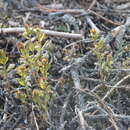More info for the terms:
cover,
forest,
frequency,
hardwood,
permafrost,
succession,
taiga,
treeFalse toadflax is found in postfire communities in the taiga of
interior Alaska. It may be present after fire in white spruce forests
on floodplains and river terraces on sites that are well drained, or in
black spruce forests that are poorly drained and underlain by
permafrost. False toadflax generally appears early in postfire
succession, increases slowly, and reaches greatest cover in late
successional, spruce-dominated forest. Mean percent frequency (f) and
cover (c) of false toadflax in postfire communities on white spruce
or black spruce sites follow [
10]:
White spruce Black spruce
Stage Postfire YR f c Postfire YR f c
_____________________________________________________________________
Newly burned 0-1 0 0 0-1 2 less than 0.5
Moss-herb 1-5 4 less than 0.5 1-5 2 less than 0.5
Tall shrub-sapling 3-30 9 less than 0.5 5-30 1 less than 0.5
Dense tree 26-45 0 0 30-55 28 1
Hardwood 46-150 6 less than 0.5 -- -- --
Mixed hardwood-spruce -- -- -- 56-90 23 1
Spruce 150-300+ 60 3 91-200+ 70 4
In northeast Alaska, false toadflax was present on one of four sites
in postfire year 4 following the Porcupine River Fire of August, 1950.
The fire had burned all or most of the undecomposed material present and
was considered "severe" on the site where false toadflax was found.
False toadflax was present in postfire years 7 and 11, but was not
reported in postfire years 23 or 31 [
11].
False toadflax had the following percent frequency and cover in
severely burned stands after the Wickersham Dome Fire near Fairbanks,
Alaska in June of 1971 [
33]:
Black spruce Aspen
f c f c
_________________________________________________________________
1971 5 .05 -- --
1972 10 .10 0 0
1973 15 .25 0 0
1974 5 .05 0 0
unburned control 90 2.60 20 .65
In postfire succession in white spruce, black spruce, and balsam fir
(Abies balsamifera) stands on Isle Royale, Michigan, false toadflax
increases with stand age. It remains relatively unimportant in stands
less than 100 years old, then steadily increases until stands reach 200+
years of age [
16].

